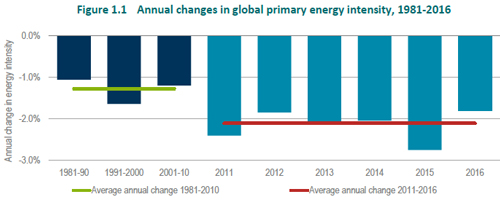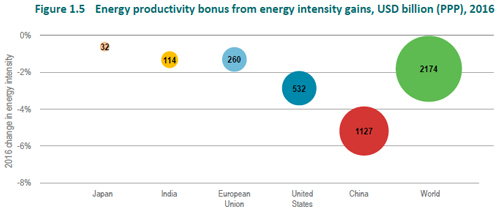IEA har just släppt sin årliga rapport om hur effektviseringen utvecklas. Denna gång med ett varningenes ord, “Energy efficiency at a crossroads”, vi står vid en skiljeväg!
More than ever before, energy efficiency is central to the achievement of a range of policy goals, including energy security, economic growth and environmental sustainability…....However, global progress has become dependent on yesterday’s policies, with the implementation of new policies slowing. If the world is to transition to a clean energy future, a pipeline of new efficiency policies needs to be coming into force. Instead, the current low rate of implementation risks a backward step.
Takten i effektivisering behöver ökas, det skrev man i sin marknadsrapport 2016, men istället har den vänt nedåt (se bild 1 nedan). Detta trots att effektvisering har en positiv inverkan på den ekonomiska utvecklingen (se bild 2 nedan) och på utsläppen av växthusgaser (se bild 3 nedan). I fallet med utsläppen är dessutom effektvisering den starkaste faktorn till förbättring.
IEA säger i en kort sammanfattning om 2017 års rapport:
• 2016 was another good year for energy efficiency, with global gains this decade outstripping those in any of the previous decades since our records began in the early 1970s
• Those energy efficiency improvements are having tremendous economic, social and environmental impacts – we highlight the implications for energy security in this year’s report
• But there was a worrying slowdown in energy efficiency implementation worldwide, putting future gains at risk.

Bild 1: Utvecklingen för energiintensitet
——————————

Bild 2: Effektvisering är bra för ekonomin (om nu någon tvivlade=
————————

Bild 3: Det är effektviseringen som håller utsläppen nere men ändå inte tillräckligt.
Skrivet av Hans Nilsson, 2017-10-09.
(0) Kommentarer • Permalink
